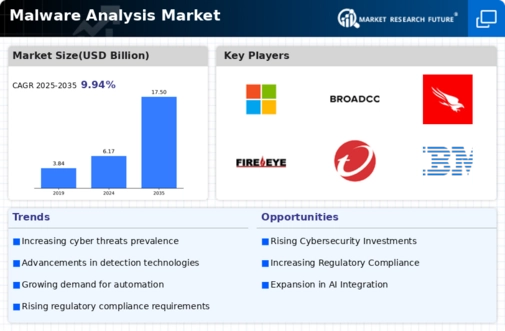Market Growth Projections
The Global Malware Analysis Market Industry is poised for substantial growth, with projections indicating a market size of 6.17 USD Billion in 2024 and an anticipated increase to 17.5 USD Billion by 2035. This growth trajectory suggests a robust demand for malware analysis solutions, driven by the escalating threat landscape and the need for enhanced cybersecurity measures. The projected CAGR of 9.95% from 2025 to 2035 further underscores the industry's potential for expansion. As organizations prioritize cybersecurity investments, the market is likely to witness significant advancements in technology and service offerings, positioning it as a critical component of modern cybersecurity strategies.
Rising Cybersecurity Threats
The increasing frequency and sophistication of cyberattacks drive the Global Malware Analysis Market Industry. Organizations face a growing array of threats, including ransomware, phishing, and advanced persistent threats. In 2024, the market is projected to reach 6.17 USD Billion, reflecting the urgent need for robust malware analysis solutions. As cybercriminals adopt more complex tactics, businesses are compelled to invest in advanced detection and response technologies. This trend is likely to continue, as the global cost of cybercrime is expected to reach trillions of dollars by 2035, emphasizing the critical role of malware analysis in safeguarding digital assets.
Growing Awareness of Cybersecurity
The heightened awareness of cybersecurity risks among organizations and individuals is a key driver of the Global Malware Analysis Market Industry. As high-profile data breaches and cyber incidents make headlines, stakeholders are becoming more vigilant about their cybersecurity posture. This awareness translates into increased investments in malware analysis solutions, as businesses seek to protect their digital environments. Educational initiatives and training programs are also contributing to this trend, fostering a culture of cybersecurity within organizations. The collective effort to enhance cybersecurity awareness is likely to sustain market growth, as stakeholders recognize the necessity of proactive measures.
Regulatory Compliance Requirements
Stringent regulatory frameworks across various sectors are propelling the Global Malware Analysis Market Industry. Organizations must comply with regulations such as GDPR and HIPAA, which mandate the protection of sensitive data. Failure to adhere to these regulations can result in substantial fines and reputational damage. As a result, businesses are increasingly investing in malware analysis tools to ensure compliance and mitigate risks. The market's growth is further supported by the anticipated increase in regulatory scrutiny, which is expected to drive demand for effective malware detection and response solutions. This trend underscores the importance of proactive cybersecurity measures in maintaining compliance.
Expansion of Digital Transformation Initiatives
The ongoing digital transformation across industries is significantly impacting the Global Malware Analysis Market Industry. As organizations increasingly adopt cloud computing, IoT, and mobile technologies, the attack surface for cyber threats expands. This evolution necessitates advanced malware analysis tools to safeguard digital assets and ensure operational continuity. The market is projected to grow to 17.5 USD Billion by 2035, driven by the need for comprehensive security solutions that can adapt to evolving technologies. As businesses continue to embrace digital transformation, the demand for effective malware analysis will likely intensify, highlighting the importance of cybersecurity in the modern landscape.
Technological Advancements in Malware Detection
Innovations in artificial intelligence and machine learning are transforming the Global Malware Analysis Market Industry. These technologies enhance the ability to detect and analyze malware in real-time, significantly improving response times to threats. The integration of AI-driven solutions allows organizations to identify patterns and anomalies that may indicate malicious activity. As the market evolves, the adoption of these advanced technologies is expected to accelerate, contributing to a projected CAGR of 9.95% from 2025 to 2035. This growth reflects the increasing reliance on sophisticated tools to combat emerging threats and protect sensitive information.


























Leave a Comment